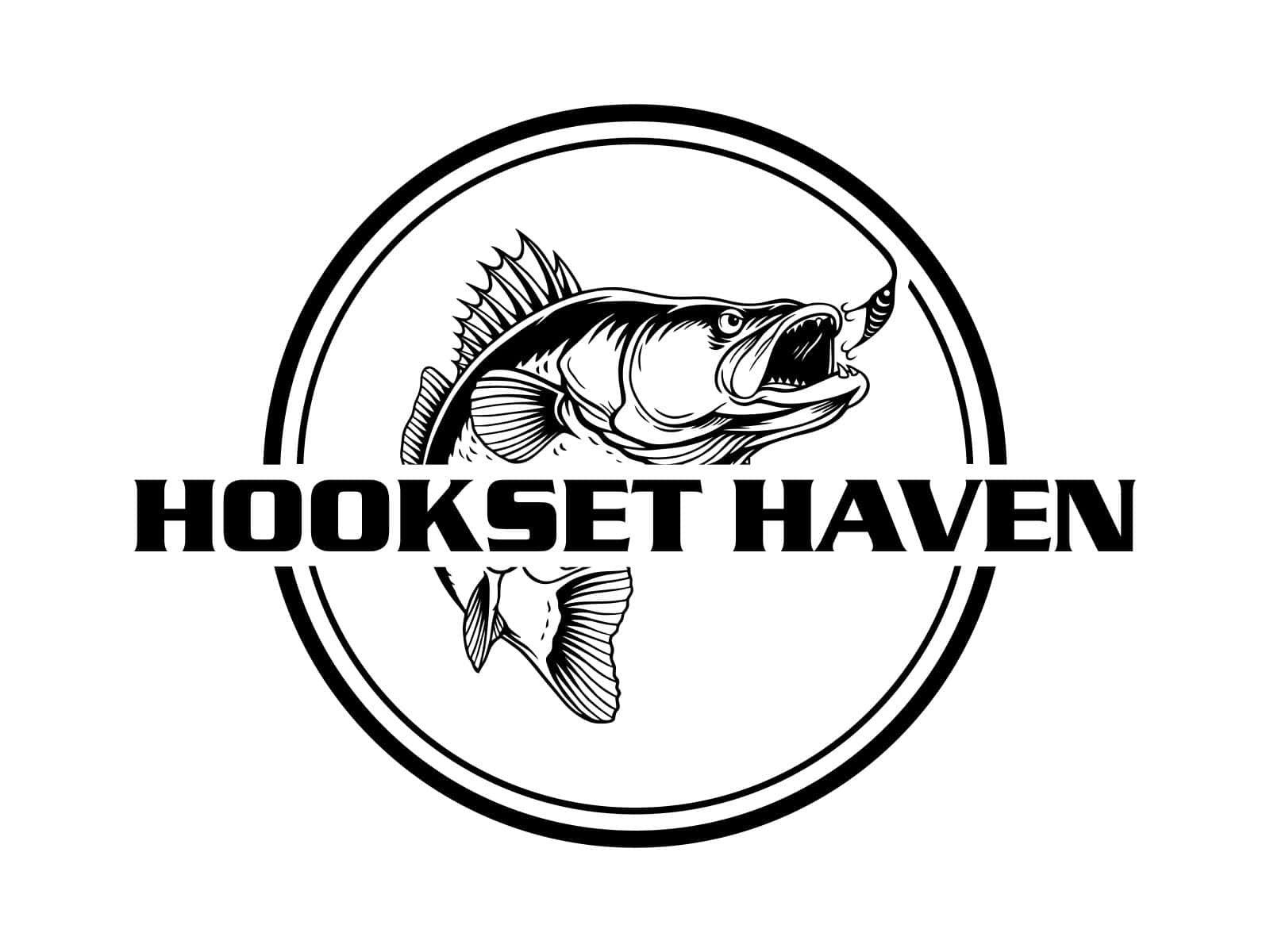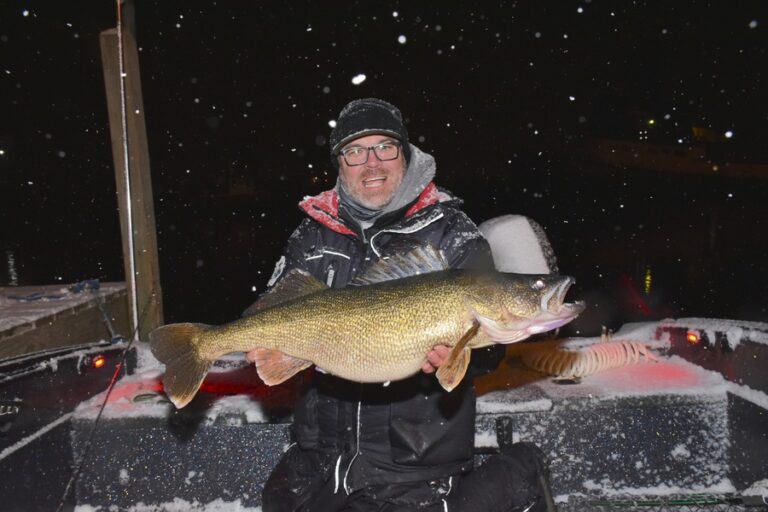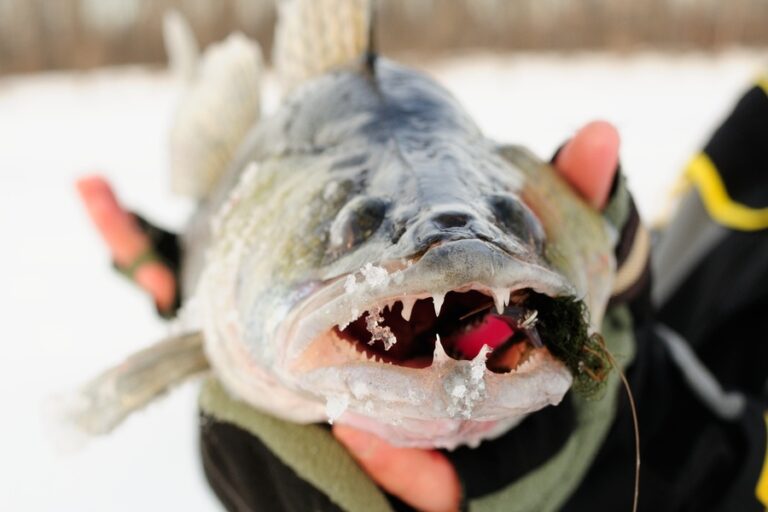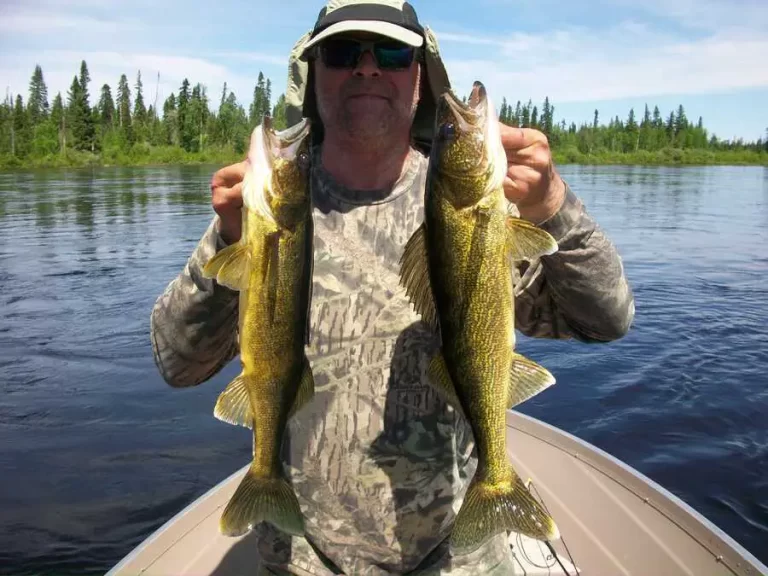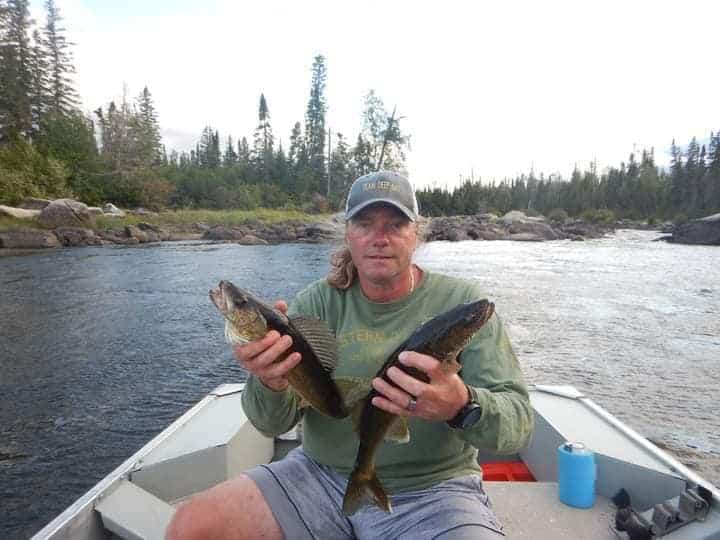Walleye Fishing in Utah (Best Lakes & Rivers) Full Guide
With its diverse range of lakes and rivers, Utah offers some surprisingly good opportunities for walleye. Although not a native Utah fish species, walleye stocked in the state thrive and provide an awesome fishing opportunity.
Utah’s prime walleye fishing is in large lakes like Lake Powell and Utah Lake, where deep, cool waters create ideal habitats. The best seasons for walleye fishing in Utah are spring and fall.
I worked seasonally in Utah on a fisheries crew doing various studies and projects around habitat improvements, creel surveys, and field sampling in creeks and reservoirs. I participated in the 2015 rotenone treatment of Red Fleet Reservoir near Vernal. I have also fished around the state for walleye including booking two fishing charters with top guides.
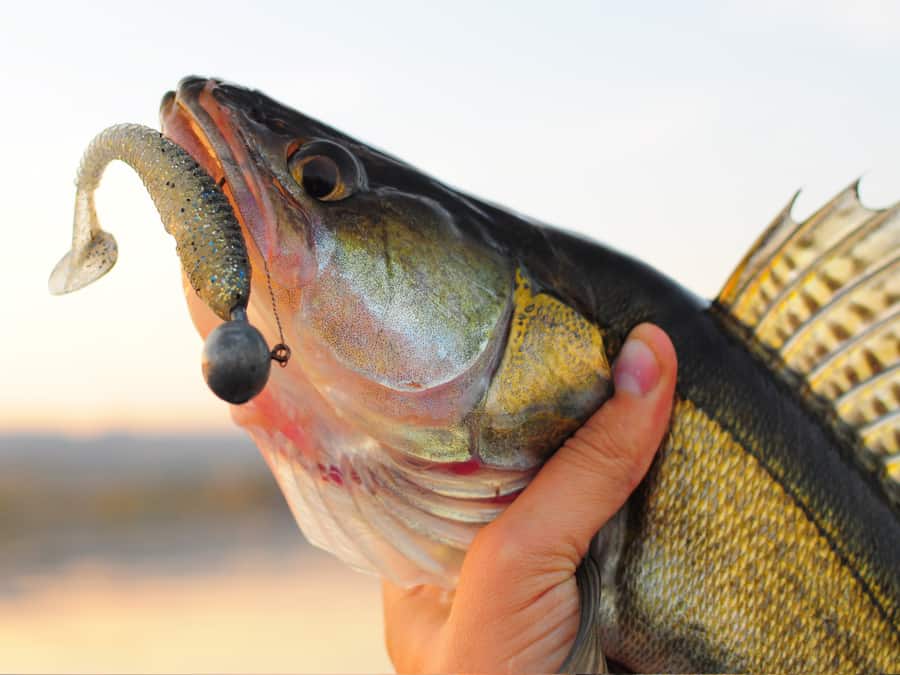
Table of Contents
Walleye Fishing in Utah
Utah offers excellent walleye fishing, especially in its major lakes like Lake Powell and Utah Lake. While it may not be as renowned as traditional walleye destinations in the north, Utah’s clear and diverse water bodies provide ample opportunities for walleye fishing.
In Utah, walleye live in deeper lake areas during hotter months, a behavior slightly different from their northern counterparts due to Utah’s clearer and warmer waters. Dropoffs and main lake humps are especially attractive.
Click here to learn about walleye fishing in Arizona. You may also be interested in Colorado walleye fishing information.
Understanding Walleye in Utah
In Utah, walleye prefer areas with clear water that offer ample cover, such as submerged structures, rock formations, or weed beds. Transitional areas like sand to gravel bottoms or deep and shallow abrupt transitions are very attractive to walleye in Utah.
Walleye behavior in Utah varies seasonally. In spring, they head to shallow waters for spawning, offering great fishing opportunities. Summer heat drives them to deeper, cooler waters, requiring specific gear and tactics for success. Fall brings them back to the shallows as temperatures cool, while in winter, they retreat to deeper areas, influenced by temperature and food sources.
Best Locations for Walleye Fishing in Utah
Lake Powell
Known for its deep waters and abundant walleye population. At over 160,000 surface acres, this super popular recreation destination is a must-fish for walleye and striped bass anglers. It should be noted this lake gets heavy fishing and boating pressure in summer and on weekends. To avoid the crowds, fish midweek and spring, fall, and winter. It offers good boat access but very limited realistic shore fishing opportunities for walleye. Walleye will be shallow near feeder streams in spring but are much deeper in summer. Focus on rocky points and deep drop-offs.
My coworker and I went on charter on Lake Powell back in 2015 and caught some nice walleye and a few big stripers. It is a gorgeous lake with excellent fishing. I strongly recommend a local guide to help you catch more and bigger fish.
Utah Lake
A large lake offering good walleye fishing opportunities. This is a relatively shallow lake by Utah standards with an average depth of only around 10 feet. Focus on the deep edges of weed lines and river inlets in spring and fall. Because the water is so shallow, it tends to be muddier than bigger deeper lakes. Use vibrating lures with color or flash to draw in walleye. This lake also gets a lot of wind so fish on windswept sides of structure and near windy shorelines. It can be a dynamite walleye fishery for medium and large walleye but avoiding the crowds will be your toughest test.
Flaming Gorge Reservoir
Renowned for its diverse fishery, including walleye. This is a beautiful reservoir right on the Utah/Wyoming border. Focus on deep rocky areas and zones near the dam. This lake offers good walleye and lake trout fishing year-round. Ice fishing can be especially good. It offers excellent boat access points and receives moderate fishing/boating pressure. I would still recommend avoiding summer weekends.
I used to hunt the mountains near the Wyoming side of the lake. I knew a lot of folks who would skip elk hunting to load the freezer up on fall walleye in Flaming Gorge instead.
Deer Creek Reservoir
A popular spot for walleye, especially near the dam. Walleye fishing can be outstanding here near the dam and deeper channels. Focus on deep structure like humps and reefs. The water is normally very clear so I strongly recommend using only fluorocarbon. The lake is popular for fishing and water sports in summer. Avoid weekends. The fishing pressure is high, especially in summer.
Tip: If you want to use braid, use it only as a mainline but attach with a double blood or uni knot a 6-12 foot fluorocarbon leader. The clear water of this lake demands a near invisible line offers with fluorocarbon.
Jordanelle Reservoir
Offers good walleye fishing, often in deeper waters. Focus on deeper water near the mainlake and dam areas. Rock attracts walleye like crazy on this lake. The higher elevation of this fishery does impact fishing some and makes fishing more lethargic in late fall and early spring. It offers good shore accessibility but you will struggle to catch walleye without a boat here. Fishing pressure is moderate with spring and fall being the best time to fish.
Starvation Reservoir
Known for its walleye fishing, especially in the spring and fall. I think this lake has one of the coolest names in the state. That alone is a good reason to fish here. It does experience strong seasonal water level fluctuations that can reduce or improve access and walleye habitat. Compared to some other lakes, it has less forage per acre which makes for more aggressive walleye but reduces their average size. Focus on rocky structures like drop-offs, ledges, and pilings. Fishing pressure is moderate but can really spike on summer weekends. Avoid these days if you can.
Yuba Reservoir
Contains a healthy population of walleye and is a popular fishing destination. This deep, large reservoir holds some big walleye. Due to snow melt inflow, water drawdowns, and drought, this lake experiences significant fluctuations in water level and habitat alterations. It offers good accessibility and boat access. Pressure on this lake is considerably less than more popular destinations on this list. Still, I recommend fishing in spring and fall to avoid contested honey holes.
Willard Bay Reservoir
A well-stocked lake with good opportunities for walleye. This nearly 10,000-acre lake offers outstanding fishing for big walleye year-round. Walleye and wipers do compete for the same fish so be prepared for mixed bags of both species when you find a strong school of bait. Focus on dikes and freshwater inflows. With an average depth of 20 feet, it offers good accessibility for boaters but shore anglers likely will not be able to catch any walleye as walleye will be further offshore. It does receive heavy fishing and boating pressure in summer and weekends.
Fish in fall and spring on weekdays for the best experience. I caught my biggest walleye in Utah on this lake in October on a Tuesday. We had our section of the lake to ourselves.
Pineview Reservoir
Offers walleye fishing along with beautiful scenery. This 2800-acre lake with a max depth of near 50 can offer some big walleye. Focus on deep weed beds and rocky points. It does get pretty crowded in summer and on weekends. Fish the shoulder seasons and mid-week to avoid crowds for better fishing. Accessibility is good for boat and shore anglers but walleye will rarely be caught from shore.
Green River
While more famous for trout, certain sections offer good walleye fishing opportunities. Focus on waters just below the Flaming Gorge dam as well as slower, deep pools along the river. Current and current-breaks will dictate walleye positioning on this river. Fish seems where faster shallow water meets slower deep water. Fishing pressure will be moderate but can vary throughout the river depending on accessibility. It offers good access points through much of the stretch of river but some areas are inaccessible. Shore fishing is very difficult for walleye fishing.
Conservation Efforts for Walleye Populations
Stocking Programs: The Utah Division of Wildlife Resources conduct stocking programs to maintain or enhance walleye populations in certain lakes and rivers.
Habitat Conservation: Efforts are made to conserve and improve habitats critical for walleye, including initiatives to maintain water quality and preserve aquatic ecosystems.
Research and Monitoring: Ongoing research and monitoring of walleye populations help inform management decisions and conservation strategies.
Be sure to reference the Utah Division of Wildlife Resources website for information about walleye management as well as to learn about fishing regulations.
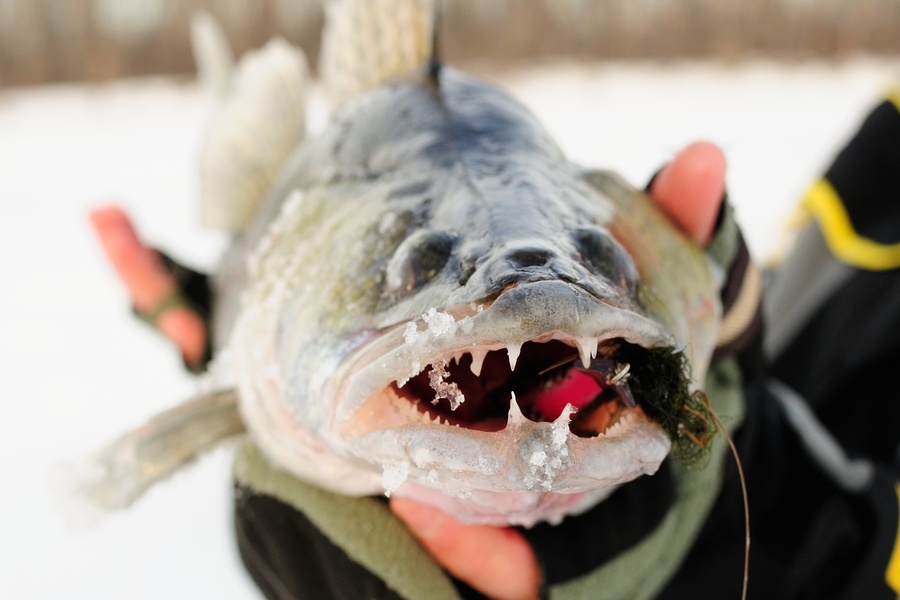
Best Walleye Baits
Table: Best Walleye Baits for Utah
| Lure/Bait Type | Recommended Colors | Recommended Sizes | Ideal Conditions/Notes |
|---|---|---|---|
| Jigs | Green, Brown, Black | 1/8 to 1/2 oz | Effective year-round; adjust size and color based on water clarity and depth. Ideal for vertical jigging in deep waters. |
| Crankbaits | Natural Perch, Silver, Walleye Patterns | 3 to 7 inches | Excellent for trolling in lakes like Lake Powell and Utah Lake. Mimic natural forage fish in these areas. |
| Spinnerbaits | Chartreuse, White, Orange | 1/4 to 1/2 oz | Effective in stained or murky water; useful around submerged structures and weed beds. |
| Soft Plastic Swimbaits | Silver, Olive, Rainbow Trout | 4 to 7 inches | Ideal for imitating baitfish in clear water conditions. Effective in larger lakes and during night fishing. |
| Minnows (Live Bait) | Natural | 2 to 5 inches | Versatile and effective throughout the year. Use on jig heads or live bait rigs for drifting or slow trolling. |
| Nightcrawlers (Live Bait) | Natural | 4 to 8 inches | Extremely popular, especially in summer. Use with spinner rigs or on a harness for bottom fishing. |
| Leeches (Live Bait) | Natural | Medium to Large | Very effective in late spring through summer. Use with a jig or under a bobber near structures. |
| Spoons | Gold, Silver, Fluorescent Colors | 2 to 5 inches | Great for deep water jigging and casting. Effective in rivers and deep lake areas. |
Most Popular Walleye Techniques in Utah
- Trolling: Use planer boards or downriggers in large Utah lakes, such as Lake Powell and Utah Lake. This method allows covering different depths and areas, which is effective for locating walleye.
- Jigging: Very effective in both lakes and rivers in Utah. Use jigs tipped with live bait or soft plastics to target walleye in deeper waters or near structures like drop-offs and submerged trees.
- Live Bait Rigging: Drifting or slow-trolling with live bait such as minnows, nightcrawlers, or leeches is especially effective in Utah’s reservoirs, including Deer Creek and Starvation Lake.
- Deep Water Fishing: Given Utah’s varied climate, walleye may retreat to deeper, cooler waters, especially in summer. Techniques like deep-water trolling or vertical jigging can be effective in these conditions.
- Night Fishing: Walleye in Utah are often more active during the cooler nighttime hours, making night fishing a productive method, especially in the warmer months.
- Use of Lighted or UV Baits: In Utah’s clear waters, lighted or glowing lures and jigs can be attractive to walleye. This is particularly true when fishing at night or in deeper, darker waters.
- Seasonal Adaptation: Adapt your techniques with the seasons. In spring, focus on shallower waters for spawning walleye. Transition to deeper waters in summer and fall as the fish move to cooler environments.
- Leveraging Local Forage: Use baits that mimic the local forage fish in Utah, such as shad or small trout, which are common prey for walleye in these waters.
- Utilizing River Currents: In river environments, such as sections of the Green River, use the current to your advantage. Position baits in slower-moving water or eddies where walleye may be lying in wait to ambush prey.
Frequently Asked Questions
What is the state record for Walleye in Utah and where was it caught?
The state record for walleye in Utah is 15 pounds, 9 ounces. This record-setting fish was caught in the Provo River.
What is the average, big, and trophy size of Walleye in the state of Utah?
- Average Size: Walleye typically range from 12 to 20 inches in length and weigh between 1 and 3 pounds.
- Big Size: Larger Walleye can reach up to around 35 inches and weigh between 5 to 10 pounds.
- Trophy Size: Walleye are considered trophy size when they are 30 inches or longer & 10+ pounds.
Is a special license required for Walleye fishing in Utah?
A general Utah fishing license is required for walleye fishing, with no special additional license needed. Please refer all licensing and regulations questions to the Utah Division of Wildlife Resources as well as your local licensed bait shop operator.
